Reverse osmosis (RO) systems are a great way to gain peace of mind about the water supply in your home.
I personally reviewed and tested dozens of reverse osmosis systems for well water using a rigorous testing procedure.
For this review, I also teamed up with one of our in-house water filtration experts, James Layton.
A biologist, James has spent the last 25 years in the water treatment field designing and testing water filtration devices and, more recently, working for state and federal agencies.
Teaming up with James has allowed me to narrow down a large list of potential products to just seven top options.
Spoiler Alert: Here’s Our #1 Pick
The SpringWell Reverse Osmosis System is my top choice for a well water reverse osmosis system.
It’s efficient, easy to maintain, and backed by an industry-leading lifetime warranty.
As a point-of-use system, it takes up little space and is much more affordable than larger systems. It passed all our tests and is well-deserving of its top ranking.
Best RO Systems for Well Water: Top Picks
Best overall: SpringWell RO System
Best whole house: US Water Systems
Best budget: APEC RO Twist
Factors We Consider: Expert Reviews From Real-World Experts
To determine which reverse osmosis system is the best for well water, I applied our seven-point testing process to narrow down the large list of possible options to the seven best.
Our water filter review process involves a detailed analysis of the technology being used, data collection and comparison, analysis from our team of water filter experts, hands-on testing, and more.
You can read all about how we review water filters to see for yourself how we created this list.
If you’re new to the world of reverse osmosis, I highly suggest you read our guide on finding the best reverse osmosis system and then come back to read our recommendations.
Best Overall Reverse Osmosis System
SpringWell Reverse Osmosis Water Filter System
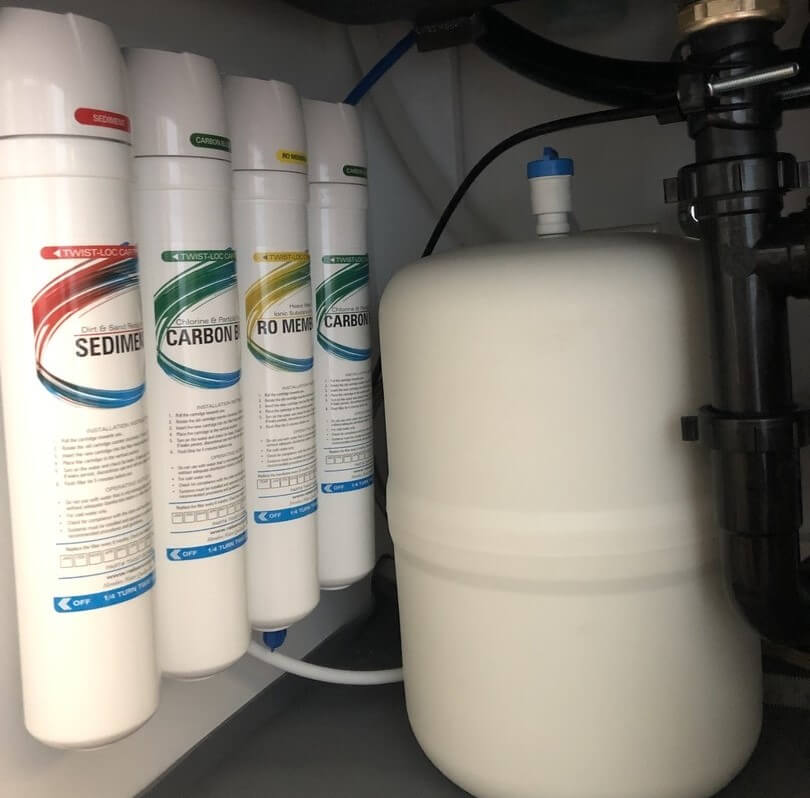
The SpringWell Reverse Osmosis Water Filter System is the best reverse osmosis system on the market thanks to effective filtration, easy maintenance, a reasonable price, and an industry-leading warranty.
Who it’s for
The SpringWell Reverse Osmosis Water Filter System is best for well owners who need to remove sediment, iron, fluoride, or salt from their water supply.
It’s also perfect for those living in agricultural areas where there may be runoff that leaves high levels of herbicides, pesticides, and nitrates in your water.
It’s also great for well owners who are worried about microbial contamination.
I should mention that if you have microbial contamination in your well, your first job should be to figure out the source and remove it.
All RO manufacturers will also recommend in this case passing your water first through a UV filter to kill microbes, and then using the RO membrane to “catch” dead organic material that can still be harmful.
Many well owners enjoy the peace of mind knowing their water is safe from harmful bacteria and viruses, and this reverse osmosis system is more than up to the job.
This is a big reason why I opted to put this system in my home. Herbicides and pesticides from nearby agricultural installations, but I also know how easily harfmful microbes can get into my well since my well cap is underground.
I have two small kids and didn’t want to take any chances, so I installed the SpringWell RO system and never have to worry again.
Why it’s the best
The SpringWell Reverse Osmosis Water Filter System is the best because it includes additional filter stages to maximize the efficacy of the reverse osmosis membrane and filter out the majority of the most common well water contaminants.
It’s also a low-profile unit that will fit in most under-sink cabinets, and it uses a 1/4 turn filter design that allows you to quickly and easily replace filters. You don’t even need to shut the water off.
I also love that it’s manufactured in the US using NSF/ANSI-certified components. It’s built to last and comes with a lifetime warranty and a six-month money-back guarantee.
This is the industry standard and goes a long way towards making this the best of the best.
Some things to keep in mind
The SpringWell Reverse Osmosis Water Filter System has many advantages, but it does have a few drawbacks.
As an under-sink unit, it’s compact, but you’re only going to get clean drinking water at one faucet. If you install this unit, you will have to remember that only water at that faucet has been treated by reverse osmosis.
Installation can also be a bit tricky for those who don’t have a lot of plumbing experience. But with some patience and a few YouTube videos, you should be able to figure it out.
If you’re still unsure, hiring a plumber to come in and do it shouldn’t be too hard and shouldn’t cost more than a few hundred dollars.
Lastly, if you do have high amounts of sulfur in your well water (strong rotten egg smell), this RO system for well water isn’t going to serve you.
The SpringWell WS1 is a whole-house filter specifically designed to tackle sulfur and is an excellent option you can add on to your RO system to tackle what RO can’t.
Final thoughts
All in all, the SpringWell Reverse Osmosis Water Filter System is the best reverse osmosis system for well water I found on the market.
Multiple stages of filtration allow it to remove most well water contaminants using a compact, easy-to-maintain system backed by an industry-leading warranty.
For clean, safe water at your kitchen tap, get the SpringWell Reverse Osmosis Water Filter today.
Best Whole-House RO System
US Water Systems Defender
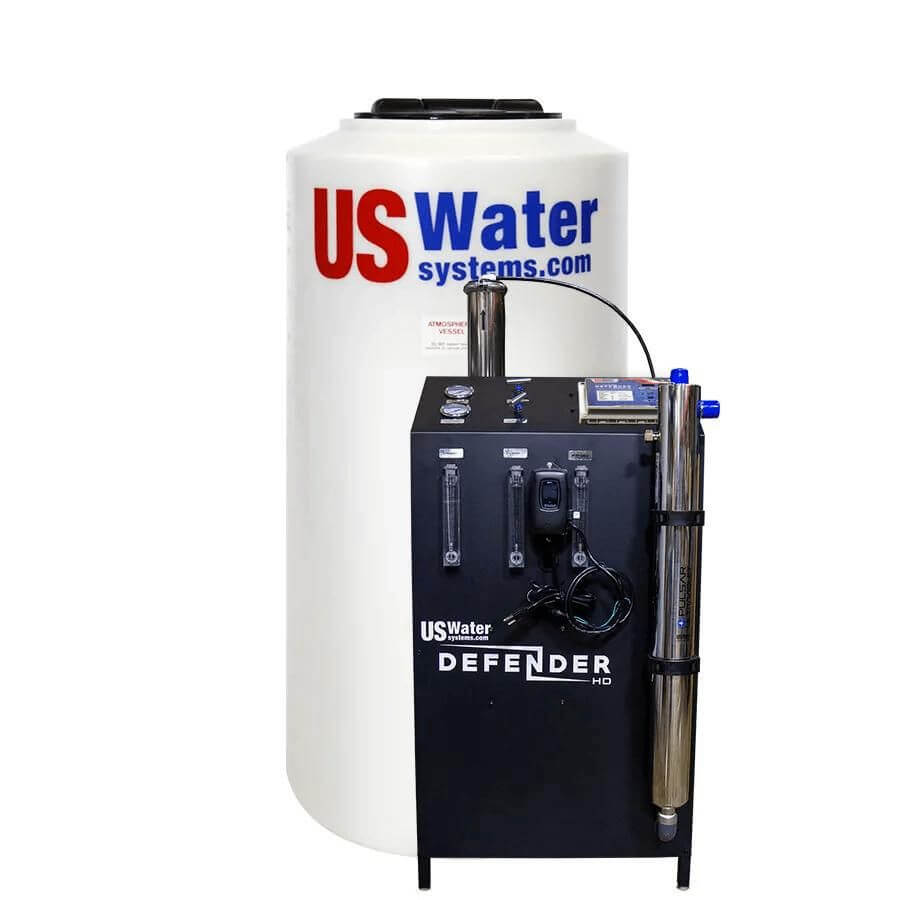
The US Water Systems Defender is different in that it’s a whole-house reverse osmosis system for well water.
It’s highly effective against the most common well water contaminants, minimizes waste, and comes standard with a UV disinfection unit.
Highlights include:
Who it’s for
The US Water Systems Defender is ideal for well owners with high levels of total dissolved solids (TDS) in their water (specifically salt but also naturally occurring fluoride) who want a whole-house solution.
Due to its production capacity and the size of the storage tank, this is a great option if you have a commercial property or multi-unit rental property using well water in need of filtration.
You’ll also be happy with this product if you’re worried about microbial contamination because it comes standard with a UV disinfection unit.
Why it’s the best
The US Water Systems Defender is a one-of-a-kind product from USWS. It’s packed with unique features you just don’t see anywhere else.
For example, the Defender’s controller allows you to have total control over your system. You can adjust the rejection rates to help maximize efficiency and maintain your desired pH level in your water.
Another exciting feature is the permeate flush, which uses RO-filtered water to flush the membrane after use, keeping it clean and extending its life.
It’s also the most efficient whole-house RO system on the market. It recycles the unused concentrate to keep waste to just one gallon for every four gallons it produces.
Plus, it has a 140-gallon storage tank and a 2,000 gallon-per-day production capacity. That is more than enough water than most people need in a home, which is why this system can also be used in some commercial applications.
If you want to go even bigger, you can upgrade to a 250-gallon tank and increase production to 4,000, 6,000, or even 8,000 gallons per day.
Some things to keep in mind
The biggest thing you will need to remember if you want to buy the US Water Systems Defender is that it does not come with any pre-filtration other than a 5-micron sediment filter.
This helps remove larger sediment particles before the water hits the RO membrane, but it doesn’t do anything against sulfur, manganese, or iron.
Also, if you have hard water (high levels of calcium and magnesium), you will need to install a softener as part of your pre-treatment system to get the most out of your filter.
It’s also not effective against chlorine or chloramines due to the lack of an activated-carbon pre-filter. But well water should not have these chemicals in it unless you or a previous well owner put it there.
This is also a very large unit that will take a big chunk of space in your basement, so you’ll need to plan for that. And due to its size and complexity, you’ll definitely want to have it professionally installed.
Lastly, as a whole-house unit with such high production capacities, the initial price tag is quite high.
But RO is one of the more expensive water treatment options out there, which is why most units are smaller point-of-use systems.
Final thoughts
The US Water Systems Defender is the best reverse osmosis system for well water if you seek a whole-house solution.
It’s excellent if you struggle with high salinity in your water, and it’s the most efficient RO system of this size on the market.
If you’re ready to transform your home’s well water, get the US Water Systems Defender here.
Best Budget Option
APEC RO-Twist
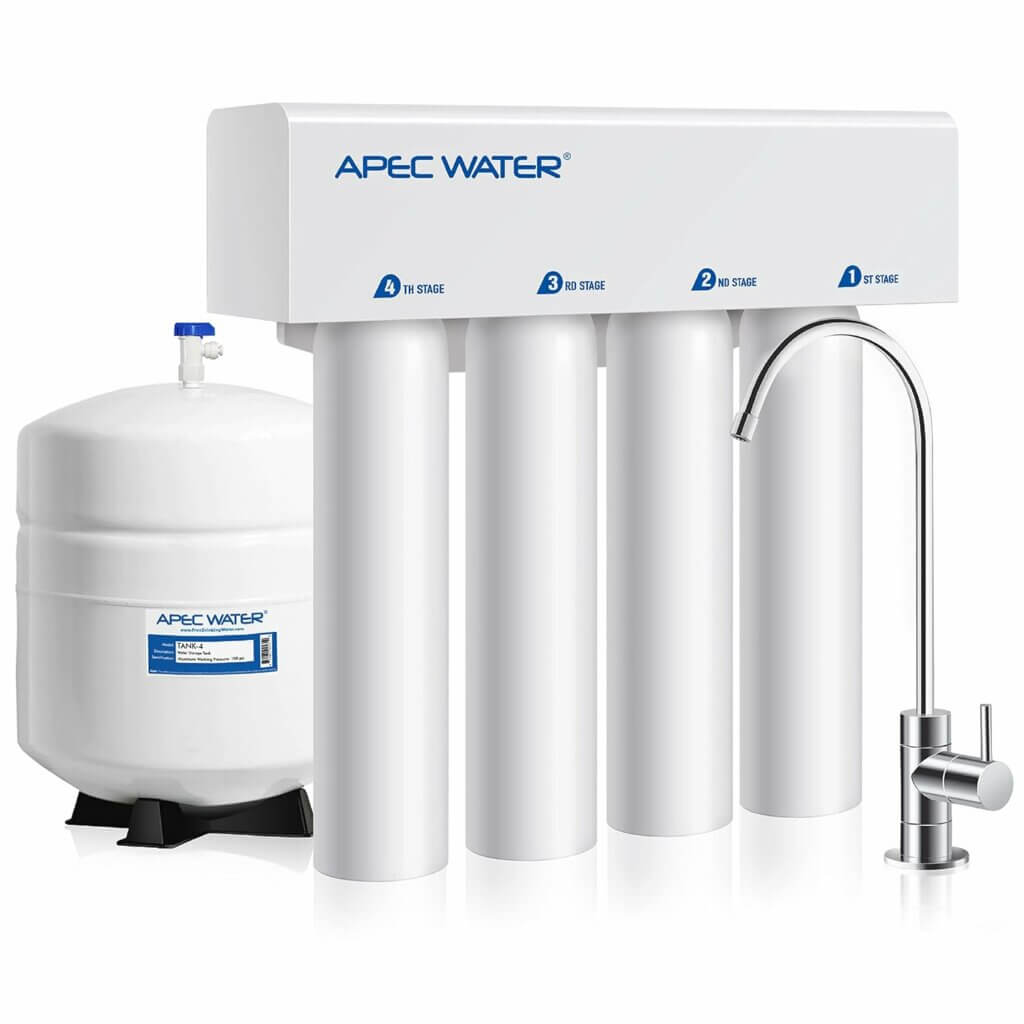
The APEC Water Systems RO-Twist four-stage system is an excellent well water reverse osmosis system for those looking for a lower, entry-level cost to the world of RO filtration.
Highlights include:
Who it’s for
The APEC Water Systems RO-Twist is an excellent choice if you want a product very similar to the SpringWell Reverse Osmosis system but don’t want to pay as much for it.
The trade-off is a much more limited warranty.
Why it’s the best
The APEC Water Systems RO-Twist is the best budget RO system because it does everything you need it to, just at a lower price point than other options.
Using a 5-micron sediment filter and carbon block filters before and after the RO membrane, this APEC system is able to trap even the smallest contaminants, such as heavy metals, nitrates, herbicides, and pesticides, as well as bacteria and viruses.
Remember, though, to inspect your well if the latter two are present and consider a UV purifier if they remain.
The unique twist mechanism also makes this an attractive option. In fact, this is a huge plus. The twist-off cartridges are so easy to remove and install.
Typical “big blue” style canisters found in most other filters require a special wrench to spin off the housing. This causes water spills when you remove the housing.
The twist-off mechanism of the APEC system allows you to change out any and all filters by hand in seconds.
Some things to keep in mind
The biggest concern I have with this product is its limited warranty. Whereas SpringWell gives you a lifetime warranty, APEC’s only lasts one year.
It will provide “lifetime” support, which is good, if vague. But a warranty is better because it can help defray costs should you uncover a defect at some point during your product’s life.
Overall, I found APEC’s customer service operation to be well above average, but the limited warranty is not ideal.
The only other concern I have with the APEC Water Systems RO-Twist is the proprietary twist-off mechanism.
It’s super convenient and makes changing filters a quick and easy process, but it is proprietary. This means if you buy this unit you will need to buy replacement filters from APEC forever.
Final thoughts
If you want an excellent reverse osmosis system for a fraction of the cost of some other systems, and you don’t mind depending on APEC for filter replacements, the APEC Water Systems RO-Twist is a great choice.
I am a big fan of this product and can happily recommend it. If you’re ready to take the plunge, get the APEC Water Systems RO-Twist here.
Honorable Mentions: Reverse Osmosis Systems for Well Water
Aquasana OptimH2O Reverse Osmosis + Claryum RO system

The Aquasana OptimH2O Reverse Osmosis + Claryum system utilizes a combination of Claryum and reverse osmosis technologies to effectively reduce a wide range of contaminants commonly found in well water, including heavy metals, chlorine, pesticides, herbicides, and more.
At the surface, this seems like a great option because it does exactly what it’s advertised to do: deliver clean drinking water.
But there are a few things that are unclear to me about the system that have me asking questions.
The first is this “claryum technology.” It appears in the process after reverse osmosis and is supposed to filter out more contaminants.
But the RO membrane has already done this as its small pores capture 99% of unwanted material. Carbon-block technology should really come before the RO to maximize efficiency.
The unit also claims to “remineralize” the water using some sort of resin, but the company is quite vague as to what this is and how much it’s able to affect the mineralization of the water.
In my experience with the product, it didn’t do much at all. It seems to me that these extra features add to the price while only marginally adding to the value.
If I were you, I would opt for one of the other options on the list, though this is still a highly effective filter using standard components.
You’re welcome to check it out on your own, and if you can figure out what makes it so special, let me know!
Home Master Artesian Full Contact RO System
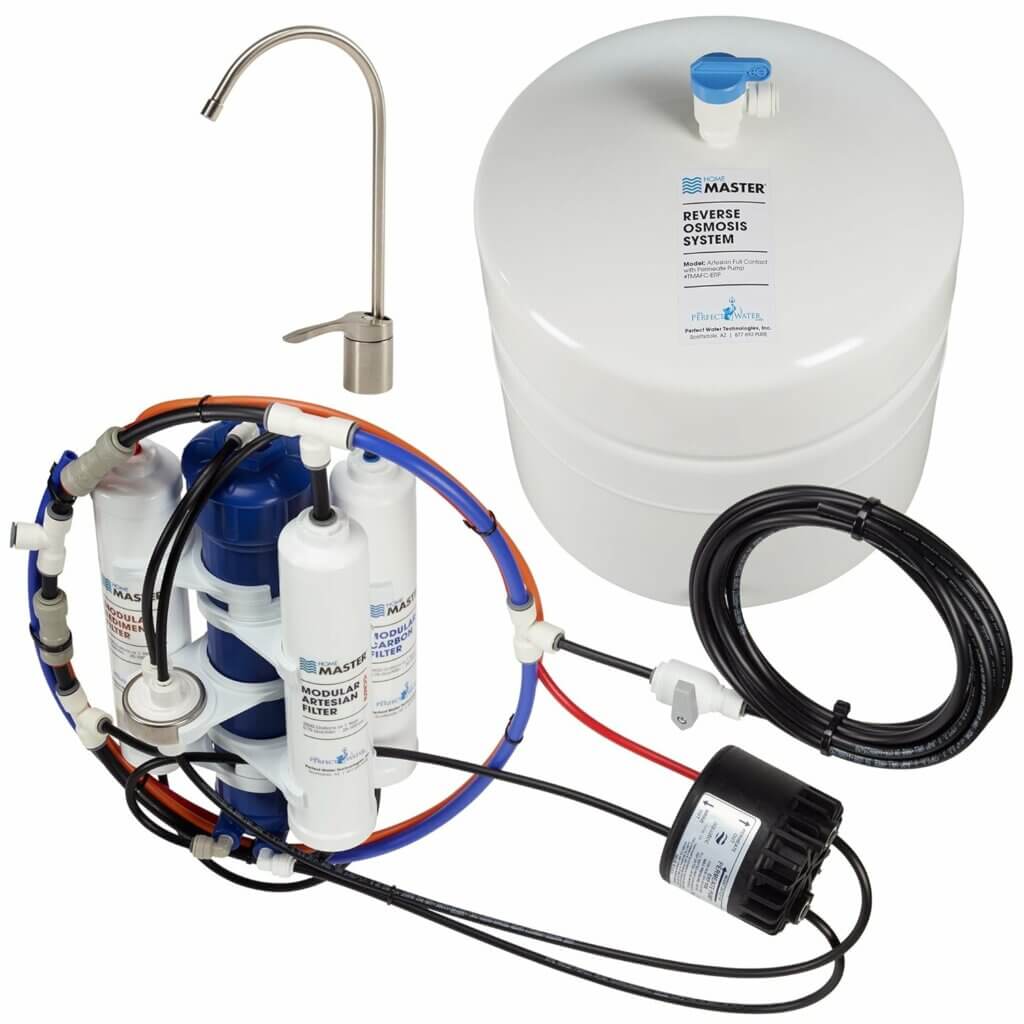
The Home Master Artesian full-contact (with permeate pump included) under-sink reverse osmosis water filter system utilizes a multistage filtration process, including a sediment filter to handle heavy metals, sand, silt, etc., catalytic carbon to handle finer contaminants, and, finally, reverse osmosis.
The clean water is stored in a 3.2-gallon storage tank under the sink and delivers clean water through its own separate faucet that must be installed.
One thing that sets this product apart is that it does not require any electricity to run.
There have been complaints by customers about vague instructional media during installation, and most attempts to contact the customer service department have borne no fruit.
The manufacturer has also acknowledged that the system’s main canister has a known defect that might lead to leaks.
If you need a reliable reverse osmosis system that will provide clean drinking water without having to worry about leaks and build quality, the SpringWell Reverse Osmosis Water Filtration System is the best choice.
Express Water Elite RO System
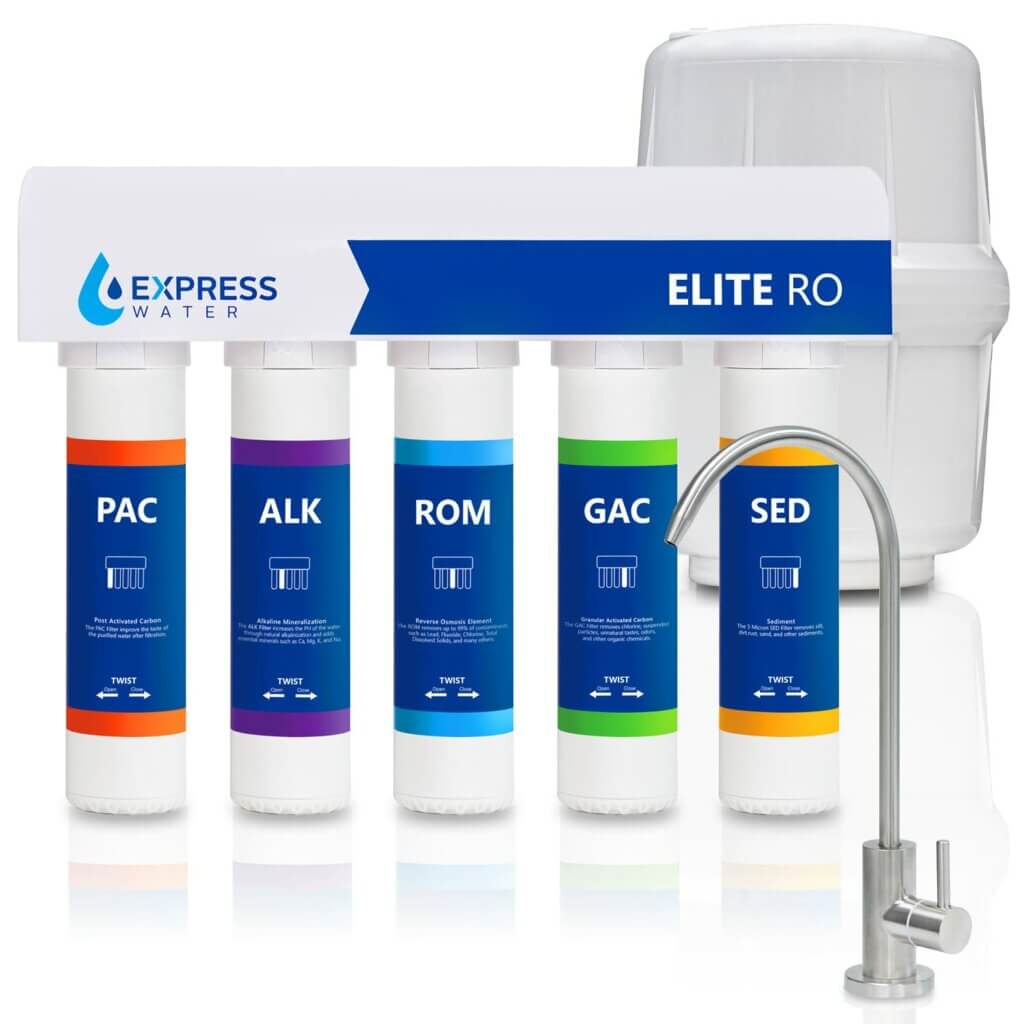
One of the Express Water Elite RO system’s notable advantages is its quick-change filter design, which allows for easy and convenient filter replacements.
The filters are designed for simple removal and installation, making maintenance a breeze.
While the Elite RO system offers many benefits, it’s important to consider a potential drawback: the system’s incompatibility with specific water pressure requirements.
Users should ensure that their water pressure meets the recommended levels for optimal performance.
WECO Ultra Whole-House RO System
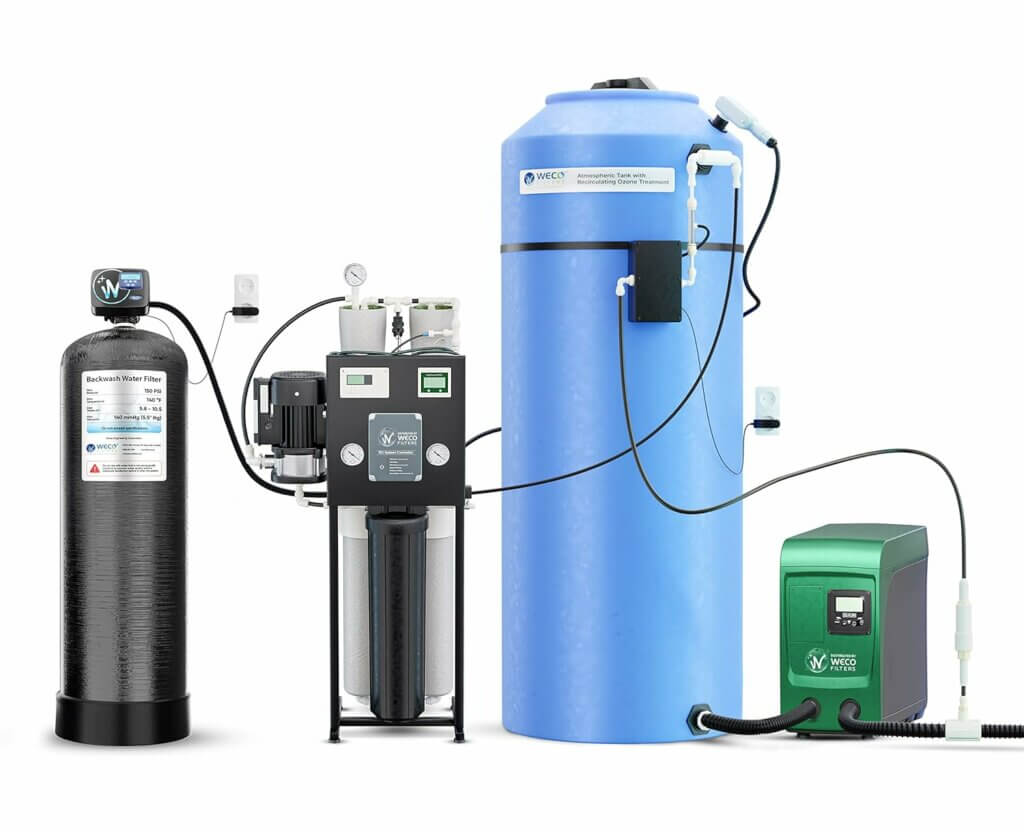
The WECO Ultra Whole-House Reverse Osmosis System is another whole-house option for those who want water filtered by reverse osmosis at every faucet in their home.
It has a 300-gallon tank and can produce up to 2,000 gallons per day.
In this sense, it’s comparable to the US Water Systems Defender, but it doesn’t have some of the other features the Defender has, such as UV purification. And it costs a good deal more.
Plus, this is an expensive and noisy machine. It has four reverse osmosis membranes and several pumps to push the water through the system.
This means you need to replace four membranes when they run out, and eventually these pumps will break, which will require maintenance.
In the end, if you have a need for a massive amount of water purified by RO, this system can work. For example, if you own a 10-unit building all occupied by tenants using the same well water source, then you can justify the expense for this type of unit.
For all other applications, I think it’s going to be too much.
Bottom Line: The Best Reverse Osmosis Systems for Well Water
Of all the reverse osmosis systems I researched, a few stood out as the best of the best.
The SpringWell Reverse Osmosis Water Filter System took the prize for the best overall RO system for wells, while the US Water Systems Defender stood out as the best whole-house option.
For those on a budget, the APEC Water Systems RO-Twist is the way to go.
Continue reading to learn more about how I did this review as well as some important things to know about reverse osmosis.
Research Methodology: How We Test and Review Products
To conduct our reviews and come to an objective conclusion about which products are best, we developed a rigorous seven-step product testing methodology.
It starts with creating a large list of all the available products and then systematically, using both quantitative and qualitative data, narrowing that list until we find the ones deserving our recommendation.
You can read more about our product testing methodology, but here’s a summary of the different factors we consider while doing a review:
Use analysis
The first step in our review is to vet products to make sure they’re designed to do what you need them to do.
For this review, this meant getting rid of products not designed for well water, but it also means making sure the products we’re examining align with the ultimate needs of you, the user.
Learn more about how we do our use analysis.
Tech check
The next step is to dig into the water filtration technology featured in a product to make sure its legit and adequate for the task at hand.
We dig into any new technologies and check them out in the literature to make sure they’re not snake oil, and we compare what different companies are doing to make sure the product in question is up to the task.
Learn more about the tech check portion of our review process.
Water test data
Data is an important part of all our reviews. We source data from public sources, our trusted partners, standards agencies, manufacturers, and, when needed, from our own labs.
We use this data to verify claims made by manufacturers and certify that the products we’re reviewing can deliver the results you expect.
Learn more about how we collect and use water test data.
Installation test
Whole-house and under-sink water filters range in complexity, and while requiring professional installation isn’t a deal breaker, we want to know exactly what’s involved.
We scour the literature, talk to customers, and run tests ourselves to get an idea of what you can expect and factor all of that into our review process.
Learn more about how we run our installation tests.
Cost-of-ownership analysis
As a homeowner, it’s important to balance up-front and long-term costs. We’re homeowners, too, so we want to make sure the products we recommend are practical and viable.
We want to be sure what you’re buying is going to make sense for you both now and in the future.
Learn more about how we conduct our cost-of-ownership analysis.
Warranty check
Water filtration systems range in price, but many are quite expensive. We often think this is worth the investment, but if we’re going to recommend you spend your hard-earned money, we want to be sure it’s with a company that stands by its products.
Before we list a product in our reviews, we do an exhaustive warranty check so we know exactly what’s covered and what’s not, as well as what else might be lurking in the fine print.
Learn more about how we do our warranty checks.
Customer service test
When making a big purchase like a water filter, it’s important to know the company you buy from is going to be with you in the long run.
As part of our review process, we run tests on a company’s customer service operation to see what it’s like and what you can expect.
This includes actually reaching out to companies as well as comparing the resources they make available to their customers.
Learn more about our customer service test.
Before You Buy a Reverse Osmosis System for Your Well Water
Reverse osmosis (RO) can tackle many of the more common contaminants in well water, but not all of them.
It is highly effective against these common culprits:
- Microbial contaminants, such as bacteria, viruses, and protozoa
- Herbicides and pesticides
- Lead, copper, and arsenic
- Fluoride
- Salt (if you live near the coast, there’s a good chance your water has salt in it and RO is the best way to remove it)
Reverse osmosis is not effective against certain elements:
- Sulfur
- Iron
- Manganese
If you have high levels of sulfur in your water, you will need to seek an alternate solution. There is no sulfur/RO combo product on the market.
Since reverse osmosis does have some limitations, I highly recommend testing your well water frequently to see exactly what’s in it and to confirm reverse osmosis is the right system for you.
But don’t take my word for it. According to Johnny Pujol, a water quality engineer at Tap Score, “With well water there is no regulatory oversight, so it’s up to each well user to ensure the water they are drinking is safe for their health. This means testing at least once a year because well water changes over time. Using laboratory testing is crucial since it’s the only way to get accurate results for low levels of toxic contaminants.”
If you still need to test, bookmark this page and come back to us when you’ve determined RO is right for you.
If you know reverse osmosis is what you need and want, click the link below to learn which products I recommend.
Back to product recommendations
You can also check out some of my other reviews about well water filters:
- Best whole-house filters for sulfur
- Best whole-house filters for well water
- Best water softeners
- Best whole-house water filter and softener combos
Dive Deeper: In-Depth Water Filter Guides
If you’re just getting started with your water filtration journey or are new to reverse osmosis, I have a number of resources available to help you. Here are some of my favorites:
- What is reverse osmosis?
- Is reverse osmosis the same as distilled water?
- Best reverse osmosis systems
- Best whole-house reverse osmosis systems
- Best tankless reverse osmosis systems
- Whole-house water filter benefits
- Best whole-house water filters
Frequently Asked Questions
Is reverse osmosis good for well water?
Reverse osmosis is good for well water if your well is contaminated with salt, heavy metals, nitrates, herbicides, pesticides, bacteria, viruses, or protozoa.
If your well has high levels of sulfur, or if it is hard water, then reverse osmosis is not going to be an effective filtration solution alone.
How much does a reverse osmosis system cost for a well?
Reverse osmosis systems for well water can cost anywhere from $250 to $10,000. The range is so large because it depends on the size and type of the unit.
Smaller, under-sink units that provide filtered water to just one faucet usually cost less than $600.
Larger, whole-house systems capable of producing and storing hundreds, if not thousands, of gallons will cost $2,000 or more.



PFAS is a major concern today, but isn’t mentioned in the article. Are these units effective at removing this as well?
Bruce,
You are correct about PFAS. More is learned about this group of chemicals every year. As of now, there are two proven methods of removalthat can easily be used by a homeowner. Prefiltration with a sediment filter followed by activated carbon filtration. The prefilter removes tiny particulates (if present) that could clog the activated carbon. The other technology is reverse osmosis.Nanofiltration also works but the RO membrane is “tighter” than nanofiltration and will remove a greater %. An RO system with a sediment filter followerd by AC filtration then RO is the best option for the homeowner at this time. An AC postfilter just makes the system even more effective.